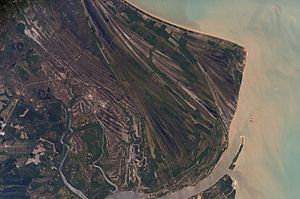Strand plain
In this article, we will deeply explore the fascinating world of Strand plain. From its origins to its impact on modern society, we will dive into a comprehensive analysis that will address all relevant aspects related to Strand plain. Through detailed research and expert opinion, we will seek to provide a complete and up-to-date view on this very relevant topic. From his influence on popular culture, to his role in technological development, we will examine every facet of Strand plain to provide our readers with a solid and enriching understanding.


A strand plain or strandplain is a broad belt of sand along a shoreline with a surface exhibiting well-defined parallel or semi-parallel sand ridges separated by shallow swales. A strand plain differs from a barrier island in that it lacks either the lagoons or tidal marshes that separate a barrier island from the shoreline to which the strand plain is directly attached. Also, the tidal channels and inlets which cut through barrier islands are absent. Strand plains typically are created by the redistribution by waves and longshore currents of coarse sediment on either side of a river mouth. Thus, they are part of one type of wave-dominated delta.
Examples of strand plains:
- Western Louisiana
- Eastern Texas
- West coast of Namibia
- South-east and south-west coasts of Australia, and in the Gulf of Carpentaria
- Letea and Caraorman, Danube Delta, Romania
- Kustvlakte, Suriname
- Cayo Costa, Florida
See also
References
- ^ McCubbin, D.G., 1982, Barrier-island and strand-plain facies. in P.A. Scholle, and D. Spearing, eds., pp. 247–279., Sandstone Depositional Environments: Memoir no. 31, Tulsa, Oklahoma, American Association of Petroleum Geologists, Tulsa, Oklahoma.
- ^ Fitzgerald, D.M., W.J. Cleary, I.V. Buynevich, C.J. Hein, A.H.F. Klein, N. Asp, and R. Angulo, 2007, Strandplain Evolution along the Southern Coast of Santa Catarina, Brazil. Journal of Coastal Research. Supplemental issue no. 50, pp. 152-156.

